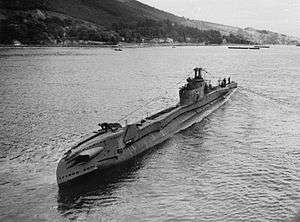HMS Thule (P325)
 | |
| History | |
|---|---|
| Name: | HMS Thule |
| Builder: | Devonport Dockyard |
| Laid down: | 20 September 1941 |
| Launched: | 22 October 1942 |
| Commissioned: | 13 May 1944 |
| Fate: | Scrapped in September 1962 |
| Badge: |
 |
| General characteristics | |
| Class and type: | T-class submarine |
| Displacement: |
|
| Length: | 276 ft 6 in (84.28 m) |
| Beam: | 25 ft 6 in (7.77 m) |
| Draught: |
|
| Propulsion: |
|
| Speed: |
|
| Range: | 4,500 nmi (8,300 km; 5,200 mi) at 11 kn (20 km/h; 13 mph) surfaced |
| Test depth: | 300 ft (91 m) max |
| Complement: | 61 |
| Armament: |
|
HMS Thule was a British submarine of the third group of the T class. She was built as P325 at Devonport Dockyard, and launched on 22 October 1942. So far she has been the only ship of the Royal Navy to bear the name Thule, after Thule, the mythological name for a northern island.
Service
Thule served in the Far East for much of her wartime career, where she sank thirteen junks, two lighters and five sampans with gunfire in the Strait of Malacca in a twelve-day period between 17 December 1944 to 29 December 1944. She also attacked a submarine, probably the Japanese submarine Ro-113 and believed she had sunk it, but Thule's torpedoes exploded prematurely and the submarine escaped unharmed. She went on to sink a further five sailing vessels and three coasters, as well as laying a number of mines.
She survived the war and continued in service with the Navy. In May 1951, Thule was sent to Canada to train with the Royal Canadian Navy.[1] The submarine was scrapped at Thos W Ward, Inverkeithing on 14 September 1962.[2] Her first commander, Alastair Mars, wrote HMS Thule Intercepts, about her operations from commissioning in Scotland to the end of the war in Australia.
References
Notes
Sources
- Colledge, J. J.; Warlow, Ben (2006) [1969]. Ships of the Royal Navy: The Complete Record of all Fighting Ships of the Royal Navy (Rev. ed.). London: Chatham Publishing. ISBN 978-1-86176-281-8. OCLC 67375475.
- Hutchinson, Robert (2001). Jane's Submarines: War Beneath the Waves from 1776 to the Present Day. London: HarperCollins. ISBN 978-0-00-710558-8. OCLC 53783010.